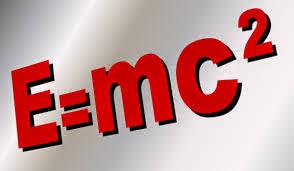This is an informative and educative blog whose main objective is promoting knowledge of different disciplines .If you find this useful, please share it with your friends.
Special Relativity
The Theory of special relativity was developed in 1905 by Albert Einstein .The Theory was the first accepted revision of Newtonian physics. It was developed to address a set of phenomena which Newtonian mechanics failed to make predictions about.Einstein postulated :first , The laws of physics are the same for all non-accelerating observers( inertial frames of reference).Second, The velocity of light in a vacuum has a constant value which nothing can exceed.Starting from these postulates and using complicated mathematics , the theory concluded that thes mass of a speeding object increases and its length shortens in the direction of motion, but this is apparently observed only when the objectapproximates the speed of light.It also concluded that time dialtes in a speeding body from a stationary observer ‘s perspective.However, the theory ‘s most important consquences are the realtionships it redefined to exist between time and space and between mass and energy.Thus, time became the fourth dimension of space (the space-time continuum) ,and mass tuned out to be the equivalent and the other form of energy as expressed in einstein’s famous equation: 2E=mc.
Classical Mechanics
Although classical mechanics is ,in fact, an an ancient discipline; it has become synonymous with the system of mechanics that was begun by Sir Isaac Newton. To day, classical mechanics includes also the theories of relativity as they are aimed at studying mechanics at the macroscopic scale. Classical mechanics constitutes one of the two branches of mechanics, and the other branch is represented byquantum mechanics which covers the microscopic scale of mechanics.Newton revolutionised physics by discovering and formulating the the three laws of motion and the law of gravitation .In his first law of motion ,Newton showed that an object continues in its existing state of rest or uniform motion in a straight line unless an external force acts upon it. The second law of motion holds that the acceleration of an object is directly proportional to the size of the force acting on it and inversely proportional to the mass of the object in question.Newton ‘s third law states that if a body exerts a force on a second body,there is an equal opposite force exerted from the second body on the first body ,i.e, for every action there is an equal opposite reaction.
The life of a star
According to modern astronomy, stars are formed when a huge mass of hydrogen gas and dust condense due to gravitation between its particles.As the condensation continues , the temperature inside the mass increases till it reaches millions of degrees and a nuclear fusion starts as result.
Stars give off energy and light by burning their hydrogen into helium, hydrogen nuclei fuse to form helium nuclei. The newly born stars are very hot and blue and as they began to cool, their colour shifts from blue to white and later to yellow.The coolest stars are red and have the largest size among all stars. During all the life of a star, there is always an equilibrium between the fusion energy that woud blow up the star and the star’s gravity that would make it collapse. After the star burns all its gas into energy,it explodes as a supernova. Depending on its mass , a star ends up as a white dwarf , a neutron star or a black hole.
Stars give off energy and light by burning their hydrogen into helium, hydrogen nuclei fuse to form helium nuclei. The newly born stars are very hot and blue and as they began to cool, their colour shifts from blue to white and later to yellow.The coolest stars are red and have the largest size among all stars. During all the life of a star, there is always an equilibrium between the fusion energy that woud blow up the star and the star’s gravity that would make it collapse. After the star burns all its gas into energy,it explodes as a supernova. Depending on its mass , a star ends up as a white dwarf , a neutron star or a black hole.
Classical vs Modern Theories
In science, the general meaning of classical theories refers to the theories which have been found irrelevant to newly observed and tested phenomena or situations.Since scientific theories are falsifiable by nature, they are all prone to becoming classical(outdated) as science develops and more evidence is discovered and systematically analysed .When theories are found incapable of addressing and explaining new scientific findings, more advanced theories must be developed to give answers to the newly emerging questions.These new theories are referred to asmodern theories. However, there is a special use of the word classical inmodern physics which refers to any theory especially in mechanics that does not incorporate the concepts of “Quantum mechanics“.Therfore, both Newtonian physics and general relativity are deemed classical by many scientists.
Black holes
Blackholes are hypothetical regions in space with extremely intensive gravitational field that no matter or radiation (including light) can escape.Black holes are believed to be the remnants of massive stars which collapse under their own gravity to a point of infinite density.Due to their nature,black holes can not be directly observed,but they are detected from the effects which they have on other celestial bodies . Stars which are under the influence of blackholes are observed by astronomers.X-rays are also emitted from the objects when they are close to theevent horizon of the black hole.
Originally posted here. http://peeweewiki.blogspot.mx/

.jpg)




